WILDLIFE
REVIEW OF 2011 - by Brian Fellows
Water
Voles
A total of 86 Water
Vole sightings were reported to me in 2011 which is a
slight improvement on last year's total of 77, but
well down on 2008 (124) and 2009 (161). Good news was
that Water Voles were seen in all sections of the
river, suggesting that several pairs were in
residence. Not such good news was the presence Brown
Rats on the river banks. Thanks to Jeff Fleming on his
long vole watching vigils for alerting us to this
problem. Rats can cause serious damage to a small
population of voles like ours, by predating youngsters
and spreading disease. David Gattrell sets traps for
rats on Peter Pond and this is something we need to
consider on Brook Meadow.
Birds
of Brook Meadow
52 birds were recorded
on Brook Meadow in 2011 from a total of 71 on the
all-time list. All the common residents were present,
ie, Wren, Dunnock, Robin, Blackbird, Song Thrush, Gt
Spot Woodpecker, Blue Tit, Great Tit, Chaffinch,
Greenfinch, Goldfinch, House Sparrow, Collared Dove
and Woodpigeon.
As for warblers, all
three of our regular summer visitors, Chiffchaff,
Blackcap and Whitethroat, arrived on time, though
their breeding success was not clear. We also had a
fleeting visit from a Cuckoo and the Cetti's Warbler,
which was regular in 2010, showed up briefly in spring
and went.
Of the corvids,
Carrion Crows and Magpies were ever present and a Jay
was often spotted flying towards Lumley, where it
probably nests. We have also had regular sightings of
Nuthatch in the north-east corner, though this is
probably a visitor from Constant Springs.
Meanwhile, on the
river, Little Egret, Kingfisher and Grey Wagtail were
frequently seen and at least 3 pairs of Moorhens
nested along the river banks, and probably Mallard, as
well, though how many youngsters survived is anyone's
guess.
Of the birds of prey,
Kestrel and Sparrowhawk were often seen over the
meadow, but we missed the 'resident' Buzzard which we
had last year. Other notable absentees in 2011 were
Water Rail, last seen in 2008, Turtle Dove, not seen
since the summer of 2008 and Mistle Thrush, which has
nested near the south bridge.
Flowers
A total of 255 plant
species were recorded on the Brook Meadow site in
2011, from a total plant list of 335. Some on the
complete list were one year casuals and others have
not been seen for many years and are probably gone for
good. However, all 12 of our sedges were found, with
Divided Sedge and Distant Sedge (a meadow indicator)
doing particularly well on the Lumley area.
Of the other meadow
indicators Hoary Ragwort showed well on the west side
of the north meadow and Strawberry Clover likewise on
the path round the Lumley area. Pepper-saxifrage came
up on the Lumley area as usual, but I could not find
any Marsh Arrowgrass despite a lot of searching!
Tall Fescue dominated
the grassland, while the rare Festulolium Hybrids were
also showing well.
As for the orchids,
seven Southern Marsh Orchids came up where two were
planted in 2005. We found 8 Common Spotted Orchids,
but Bee Orchids (2 plants) and Pyramidals (only 1)
were very hard to find.
Of the two plants that
I count every year on Brook Meadow, Butterbur
continues to go from strength to strength with a
record 859 flower spikes in 2011. A large increase
over the past three years is mainly due to the
continued spread of plants onto the meadow in front of
the seat, which now accounts for over 40% of all the
plants on the meadow. In contrast, I was only able to
find a maximum of 214 flowering plants of Ragged Robin
on the Lumley area, which was well below the record
set last year of 625, but that was
exceptional.
Insects
21 species of
butterfly were seen on the meadow in 2011, including
Brown Argus and Ringlet, which are fast becoming Brook
Meadow regulars. Meadow Brown and Gatekeeper were
abundant in the summer, but Small Tortoiseshell
continues to be scarce. Of the migrants, Painted Lady
was very scarce and Clouded Yellow was not seen at
all.
Of the other insects,
we had plenty of Ladybirds, Soldier Beetles,
Froghoppers, Hover flies, Meadow Grasshoppers and
Bush-crickets. Richard Somerscocks spent hours
stalking damselflies and dragonflies with his camera
lens and got some great images for the web sites.
CONSERVATION
REVIEW OF 2011
- by Wally
Osborne
Practical
Work
Out of 24 practical
work sessions held during the year 2011, only 1 was
abandoned due to bad weather, a testament to the
dedication of all of the average 10 Volunteers per
session, who put in a total of 480 hours of
conservation effort. As always the sessions were
organised to BTCV standards, with our 4 experienced
Volunteer Leaders providing the task and safety
briefings and latterly, joined by 2 newly qualified
Leaders Lesley Harris and Maurice Lillie who will
share the load in future.
General work -
The cruel weather of early 2011 left the Meadow a
sorry sight but, in the first quarter, we managed to
complete a good amount of formative pruning and
selective bramble control plus the finishing of our
annual schedule of the grassland mosaic cutting.
Palmers Road Copse paths were spread with wood
chippings arising from some nearby tree surgery work
and a lot of effort was put into blocking off
unauthorised paths out of Gooseberry Cottage onto the
South Meadow, plus creating dead hedges on riverbanks
to protect Water Vole habitats from dog
intrusions.
Path
maintenance - The vigorous spring vegetation
growth always creates work for us in keeping the
occasional paths open to all visitors through both
hand and power scythe cutting, whilst appreciating the
wonderful wild flowers developing. Some new paths were
cut in an attempt to relieve footfall on some of the
heavily used stretches, and as ever, visitors created
their own new routes which we try to discourage by
brushwood barriers, particularly around the North
Meadow wild flower rich area.
Annual cut -
The annual cut by our Contractor (paid for by HBC),
began rather late this year, following the standard
practice of mosaic cutting non-adjacent sections,
which had not been cut in 2010. This work included the
cutting of the heavily overgrown northern most part of
the South Meadow, not done for many years and now
included in a 3-year rotational cut system. A further
benefit from this work was the access provided to the
Alder Buckthorn plantation to enable it's
nurturing.
Special
projects - In the last quarter, two rather special
projects were begun at the instigation of the New
Committee, in addition to the usual work of keeping
the site tidy and free from litter. Firstly, the
Hawthorn hedge planted in the North Meadow about 7
years ago was 'laid in the midland style' by a strong
team led by Mike Probert and, as he said, it is 'a
pukka job'. Secondly, they decided to plan and execute
the extension of the Native Hedgerow along the western
boundary of the Seagull Lane patch, taking advantage
of the Woodland Trust scheme, which celebrates the
Queen's Jubilee. This project entailed the somewhat
controversial removal of a large patch of brambles and
it is now ongoing towards the planting date of 4th
March 2012.
Tree Work - The
big stock of Crack Willows across the site need
regular attention and 3 in Palmers Road Copse were
pollarded by HBC early in 2011 whilst volunteers
started the 'cut back' of many big branches fallen
across the river below the North Bridge. In late
summer, a huge collapse of Crack Willow across the
river 'S bend' required a big clearance effort by
volunteers, supported by HBC's Andrew Skeet. HBC and
BMCG shared the cost of the tree surgery work needed
to complete the clear up of the area and we now look
forward to the spring growth masking the
'desolation'.
Child visits -
During the year we welcomed visits by the Emsworth
Guides as part of their 'Service to the Community' and
also 4 pupils of Glenwood School who helped with our
work. We thank Pam Phillips for providing hot tea,
coffee and biscuits to volunteers, whilst being a very
active one herself.
Annual
Inspection of Brook Meadow Trees
The annual inspection
of the Meadow estate of trees by HBC Arborist Andrew
Skeet, took place on 16th December with the Group
represented by Maurice Lillie and Frances Jannaway.
This inspection enables us to give Andrew our views
and also aids his preparations for his Budget for year
2012 / 13. The visit was very constructive and the
following work may be done during January 2012: In
Palmers Road Copse a number of Crack Willows will be
pruned and a White Willow pollarded. On the eastern
riverbank in South Meadow, two large Crack Willows
leaning towards the footpath will have their lower
branches removed to reduce the load upon them. At the
river 'S' bend east bank in the North Meadow, a
previously pollarded Crack Willow will be done
again.
Final
word
As your new Chairman,
I would like to thank all Members for their continued
support of the work of BMCG through their
subscriptions and donations, both large and small. We
can always use of some additional Volunteer Workers
but if you are unable to help in a physical way, your
moral support and financial contributions enable us to
maintain the meadow as a much loved Local Nature
Reserve.
WORK
SESSION - THURSDAY DECEMBER 15 - 2011
Report by Brian
Fellows
Bramble
clearance
I went over to the
meadow this morning mainly to take photos of the work
party continuing to clear the roots of Brambles from
the Seagull Lane patch. I was asked about planting in
the cleared area. I suggested that they do not attempt
to plant anything new in the cleared area, as there
will be a good existing seed and rhizome bank which
would dominate anything new. In any case, it will be
interesting to see what comes up in the spring in the
disturbed ground.
The
workers on the Seagull Lane Patch
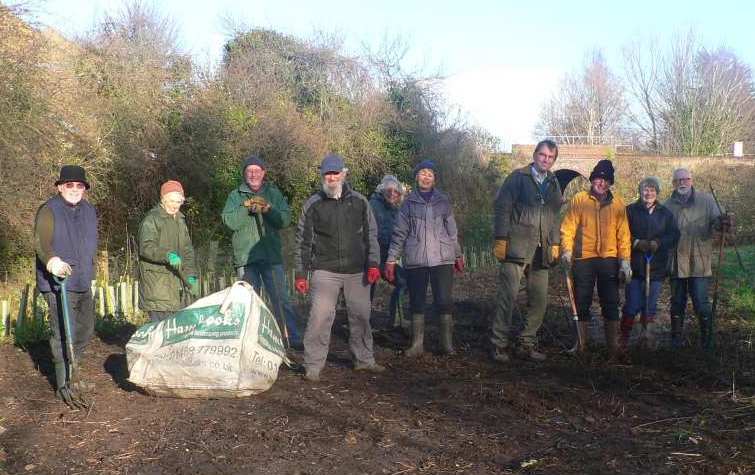
Clearing
the brambles
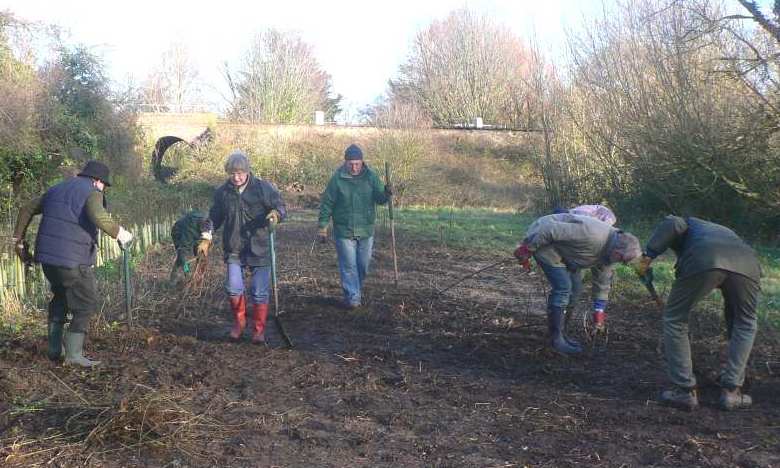
Hawthorn
hedge laid
Mike explained how he
and others had laid the Hawthorn hedge on the west
side of the north meadow in the past week. The line of
Hawthorns, originally planted by the HWT Watch Group
several years ago, had grown very tall and was ideal
for laying. Mike used some surplus stakes and binding
from the Chichester Harbour Conservancy work at
Salterns Copse. In a few years time the stakes and
binding will have rotted and the hedge will be
sprouting well. At this stage it should be trimmed at
the top to encourage it to bush. Laying of hedges is a
practice that goes back to medieval times to contain
stock.
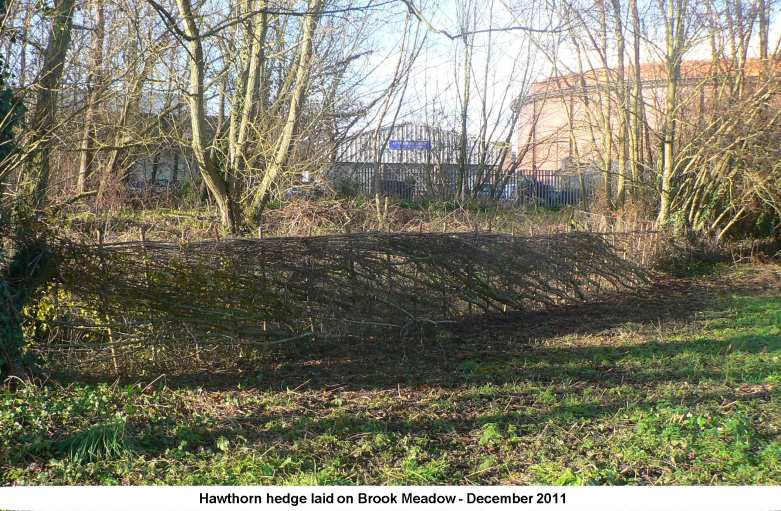
WORK
SESSION - SUNDAY 4 DECEMBER 2011
Report by Wally
Osborne
Photos by Brian
Fellows
10 Volunteers turned
out on a cold, grey but dry morning and after the
briefing at Lumley Gate, we decamped into the north
meadow and the Seagull Lane patch. The north meadow
group took advantage of the continuing low water
levels in the River Ems, to rake out all of the
accumulated winter tree debris, onto the riverbanks,
and at the same time remove any litter. In this way,
the stretch of river from the NW corner through to
below the 'S' bend was cleared so that increased water
flow will not cause any blockages.
Maurice
and Dave busy in the river by the S-bend
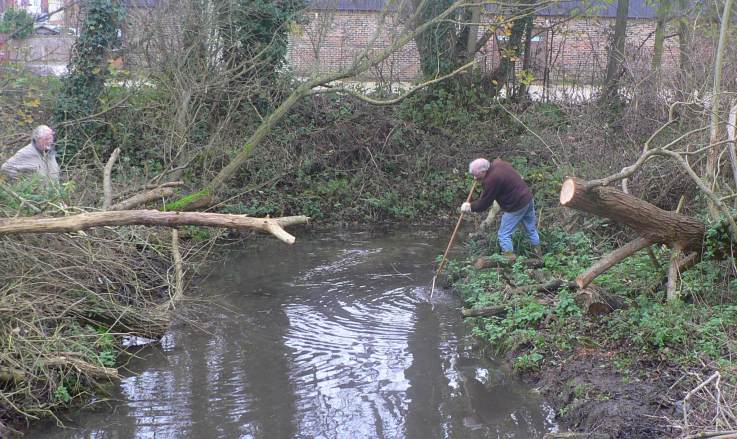
The larger group went
to the Seagull Lane patch, where our contractor's
clearance job (see Native Hedge Project Extension
below) left behind a field of bramble and nettle
roots. We set to with forks to dig out as many roots
as possible before raking the cleared area of all
arisings and taking them to the sacrificial dump area.
This was a really tough job and the volunteers stuck
at it 'manfully' and 'womanfully', to make an
excellent start on a task, which will occupy a few
more workdays ahead.

Richard
and Mike struggling with a reluctant Bramble
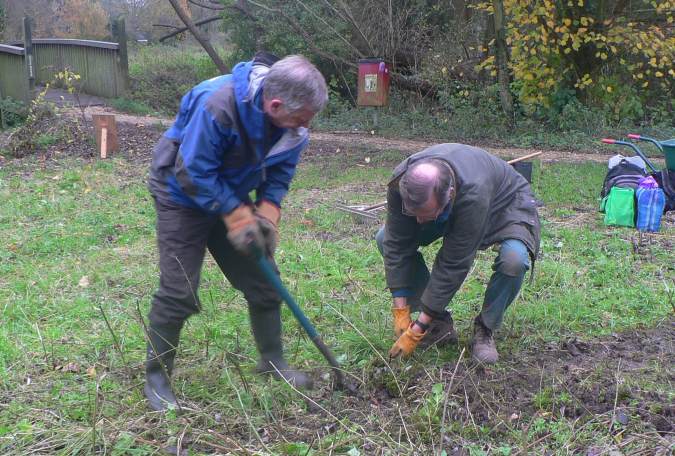
We know very well that
the brambles will start to regrow in the spring but
our future tactics will be to keep this area under
control, since there are very ample bramble patches
close by. Many thanks for the dedication and effort by
Jennifer, Maurice, Patrick, Richard, Mike, Tony,
Gordon Dave and Penny.
Penny
keeping the meadow nice and tidy
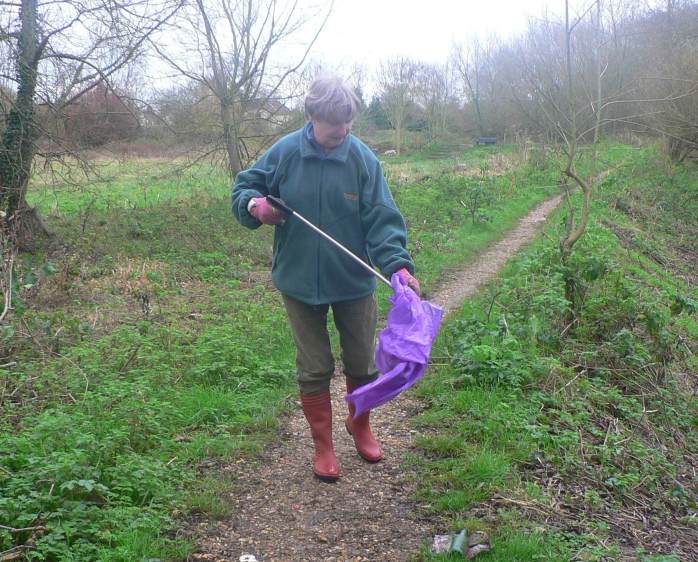
Forthcoming work
sessions: Thursday 15th December & Sunday 8th
January 2012 Come and join us for the next workday
when seasonal refreshments will be
provided.
Native
Hedge Project Extension
A couple of years ago,
a native hedgerow was planted along a section of the
western boundary of the Seagull Lane patch and it is
now getting quite well established. We have decided to
extend the hedge by about 20 metres, up to the railway
embankment fence. The Woodland Trust Jubilee Woods
project is giving both trees and hedgerow plants free
of charge to approved organisations and BMCG have been
selected as a worthy cause. Preparations for the
extension are already underway and you may have
noticed that the large patch of brambles has been
scrapped off and the arisings pushed as far as the
embankment fence. This action may appear to be drastic
to some but the Committee decided that the timing was
right for it and our next workdays will see the site
tidied up ready for a new length of stock fencing to
be erected, protecting the site. The planting strip of
ground will then be prepared for planting of the
'native hedgerow whips' with their protective sleeves,
in early March 2012. At that time we will be looking
for extra help with the planting and would therefore
encourage both old and new Volunteers to come along
and help with this worthwhile project. Details will be
published in the new-year. Project completion will
enable us to restore the newly 'exposed ground' back
into a wild flower rich meadow, joining into the rest
of the Seagull Lane patch.
Hedge
Laying
We've talked about the
need to 'lay' the short Hawthorn Hedgerow planted some
years ago and located near to the central line of
Crack Willows and intended to provide both a habitat
and a food source for birds. The job has now been
organised to go ahead on Tuesday 6th & Wednesday
7th December (weather permitting), using stakes and
ties obtained free of charge by Mike Probert. Mike has
some experience & training in hedge laying and a
rota of Volunteer Member helpers will support him
during both mornings & afternoons. We are
uncertain how long the job will take us but if you
would like to watch the work in progress or even
assist, just turn up on the appointed days.
Wildlife
Observations
by Brian
Fellows
A small group of
Wood Blewitt (Lepista nuda) toadstools
were growing where the bramble clearance was taking
place on the Seagull Lane patch. Most were young
specimens, with rounded thick fleshy caps and solid
stems, though there was also one older one with a flat
cap and wavy margin. However, the most distinctive
feature of this fungus is its blue-violet colour.
Ralph Hollins drew my attention to an alternative
identification - the Amethyst Deceiver, but having
seen the second photo below, he agrees with Wood
Blewitt.
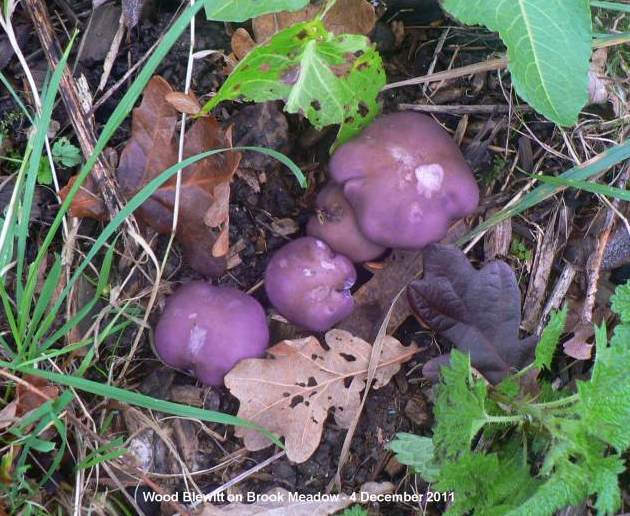
Here
is a photo showing the purple gills and chunky stem of
a young specimen
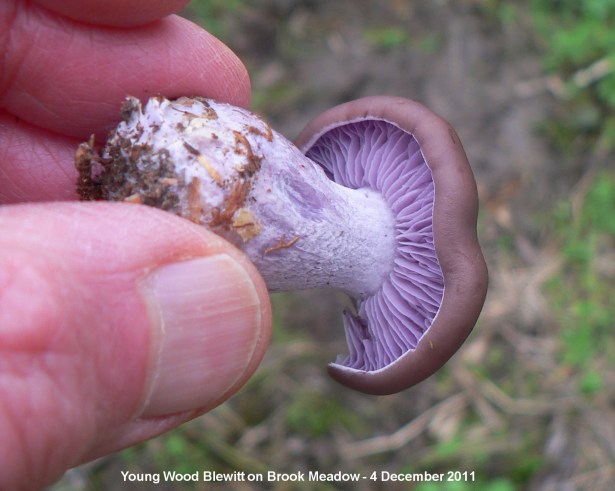
A clump of Honey
Fungus is growing at the base of a pollarded Crack
Willow tree on the western side of the south bridge
over the river. Not a serious threat to the trees in
that area, but worth knowing about.
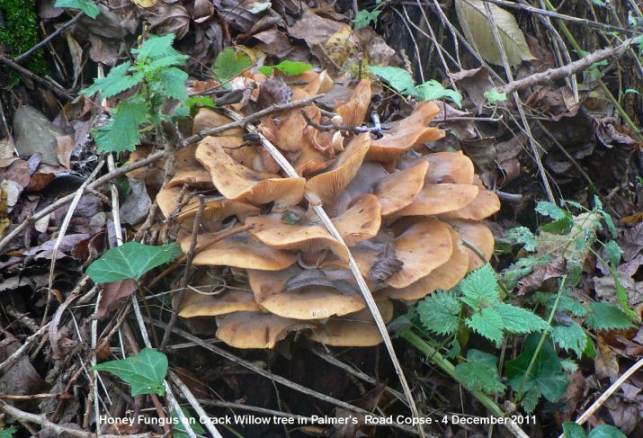
Dog
dips
I read in the current
Wildlife Trust magazine (Winter 2011) that two dog
dips have been installed on the Itchen Navigation
canal. They are the first of their type to be used in
the UK. They hope that the dips will reduce bank
erosion to the benefit of wildlife, such as Water
Voles, as well as providing a suitable place for dogs
to swim. Maybe, this is an idea the Conservation Group
might consider for the control of dogs entering the
River Ems on Brook Meadow.

Saturday
19 November 2011
Work
Party with Hampshire Wildlife Trust Watch Group
Report and photos by
Lesley Harris.
Six young people with
their leader, Sally Rumfelt and assistant Judy, plus
two accompanying adults, turned up in the warm
sunshine to help rake and bag the arisings from the
mown wildflower area in the North Meadow. Great fun
was had dragging, spreading and trampling in the
sacrificial area. Oliver, the oldest boy, was inspired
by the power scythe and helped Richard to move and
clean the machine. It was great to see Richard
Jannaway working in Brook Meadow after so long hors de
combat. Isla, Erin and Sarah were the indefatigable
workers, dragging heavy branches to protect the
wildflower area from excessive footfall. Several boys
and girls had a go at using a bow saw. Frances led the
work session assisted by Jennifer, Lesley and Pam, who
also provided welcome refreshments. One lesson we
learnt was to request that girls (and boys) with long
hair tie it up to prevent it getting tangled up
between branch and bow saw!

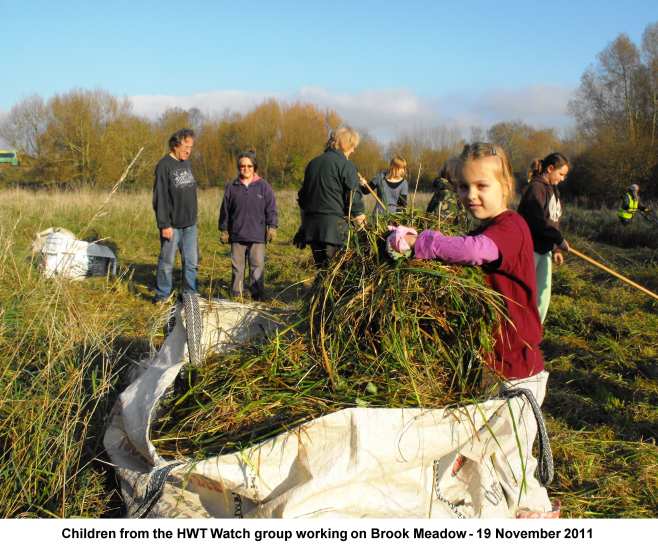
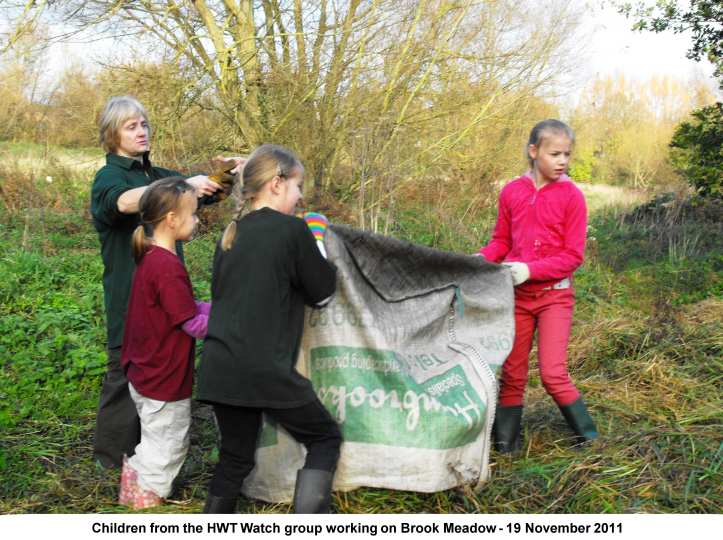
Curtis,
wearing camouflage jacket and hood, disappeared into
the soft heap for several rests.
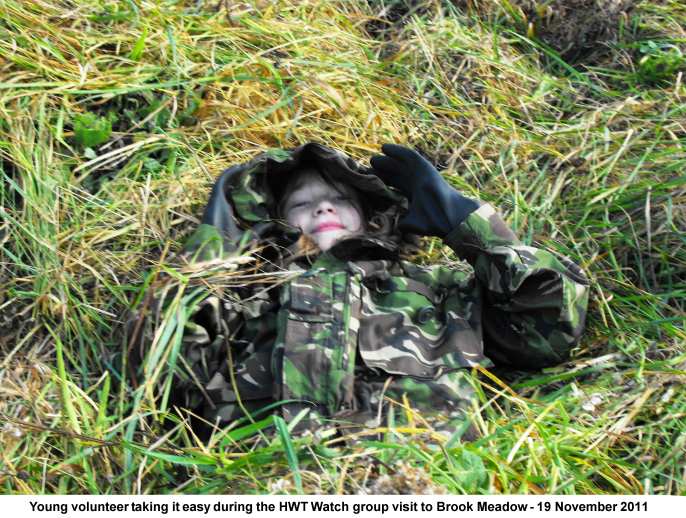
Laura
was delighted to find a Field Vole nest
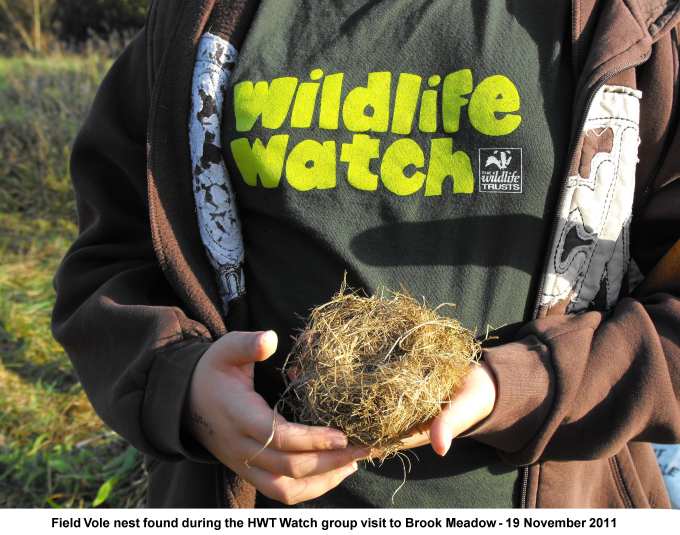
Thursday
17 November 2011
Work
session -
report by Frances Jannaway
Splendid warm and
sunny weather greeted the 12 volunteers including a
new volunteer, Jane, for the last work session in
November. The main task was to cut, rake and remove
the arisings from the Lumley wet area which was
successfully completed with Maurice on power scythe by
the tea break provided as always by Pam. Another task
was to carry out a thorough litterpick of the whole
meadow including Palmers Road copse. This yielded 3
bags of rubbish including a bird feeder and a pair of
shoes. In addition, all the sign cases were given an
expert clean by Lesley. Finally, several paths in the
central and north meadows were widened with Patrick
and Phil on power scythe and the arisings raked and
removed. The same treatment was given to the area
around the Hawthorn hedge just north of the central
line of willows in preparation for it being laid by
Mike and Co. in a few weeks time.
Photos by Brian
Fellows
There
was a good turn out for this morning's work
session
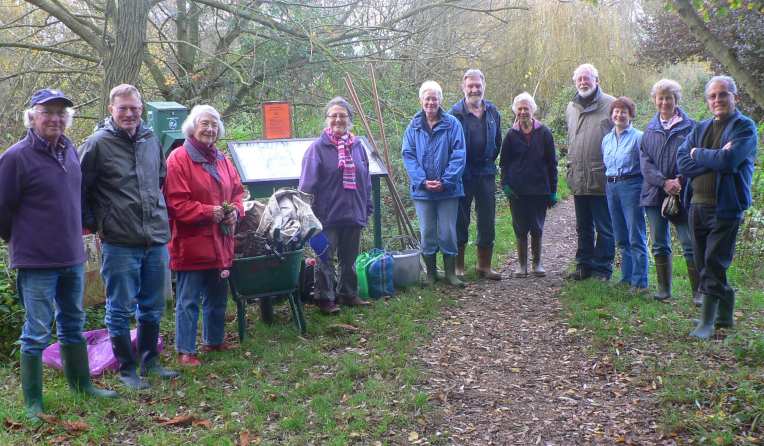
Maurice
made a start on cutting the Lumley Area before we
arrived
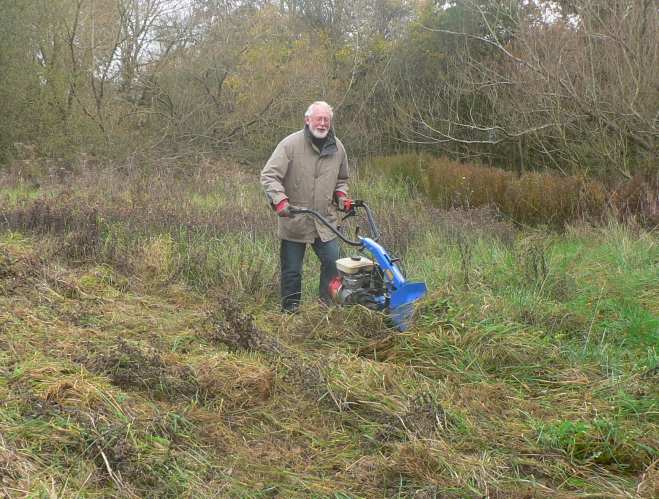
Everyone
got down to raking up the cuttings
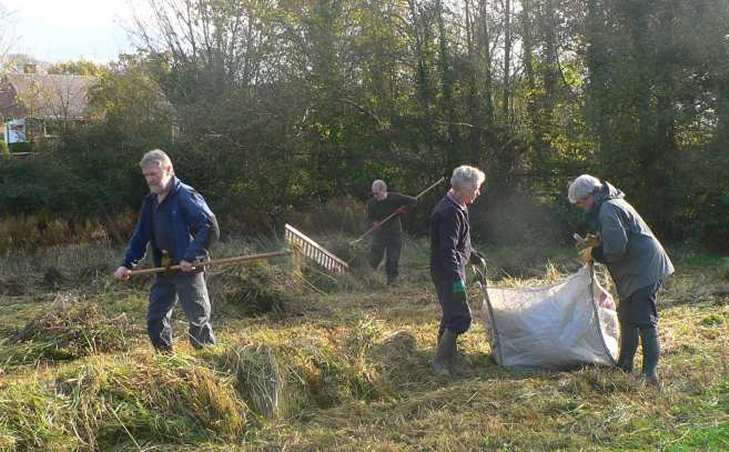
It's
hard work
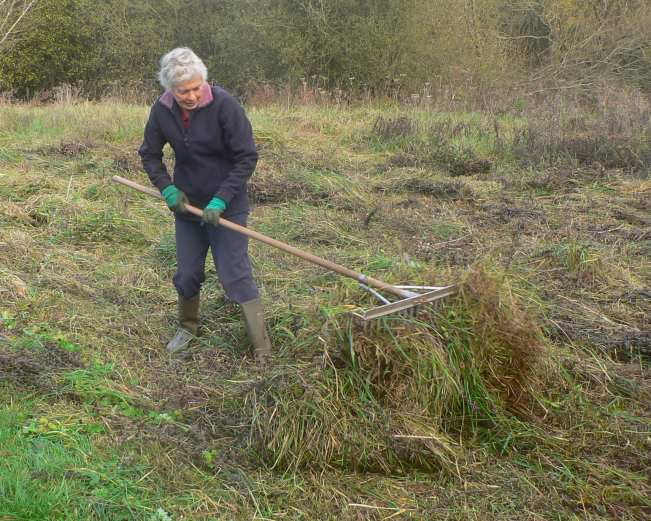
And
bagging them
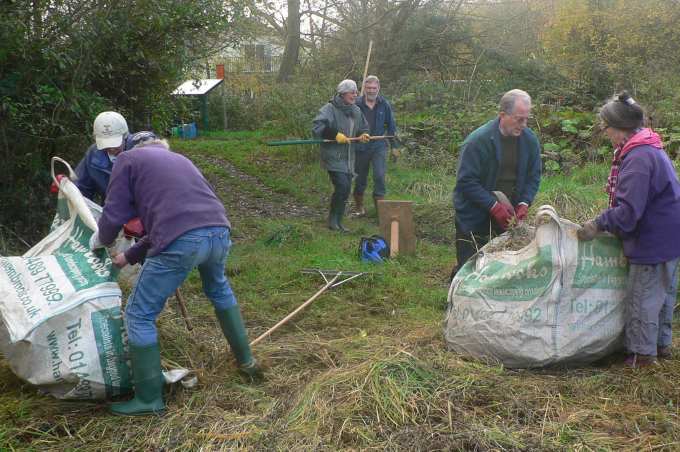
That's
quite a bagful to drag
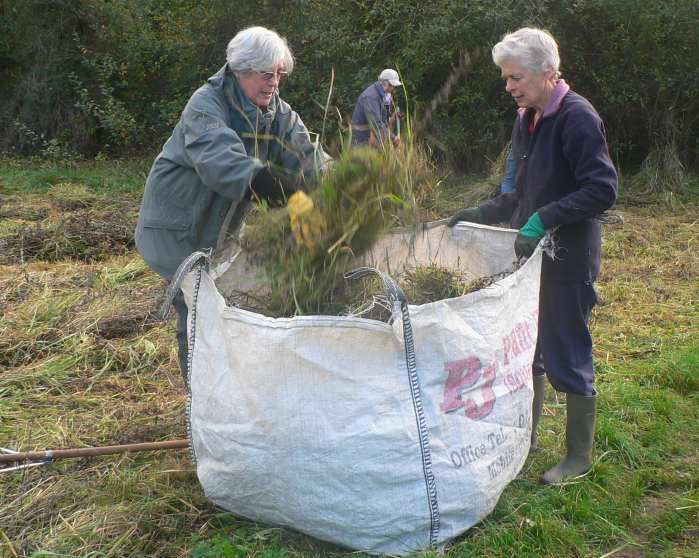
Not to
forget the litter collectors in palmer's Road
Copse
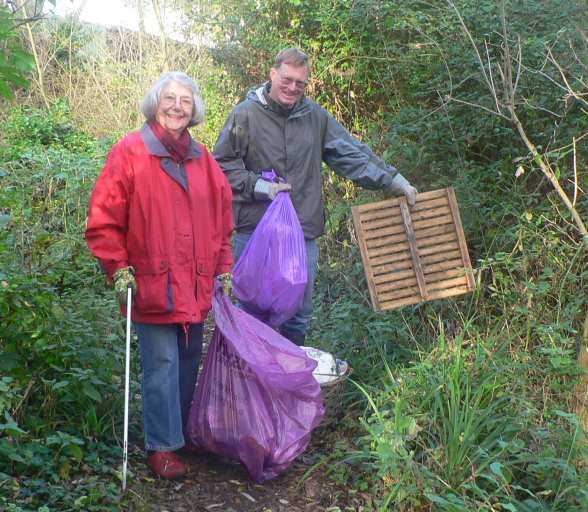
And
Lesley cleaning the Water Vole
signcase
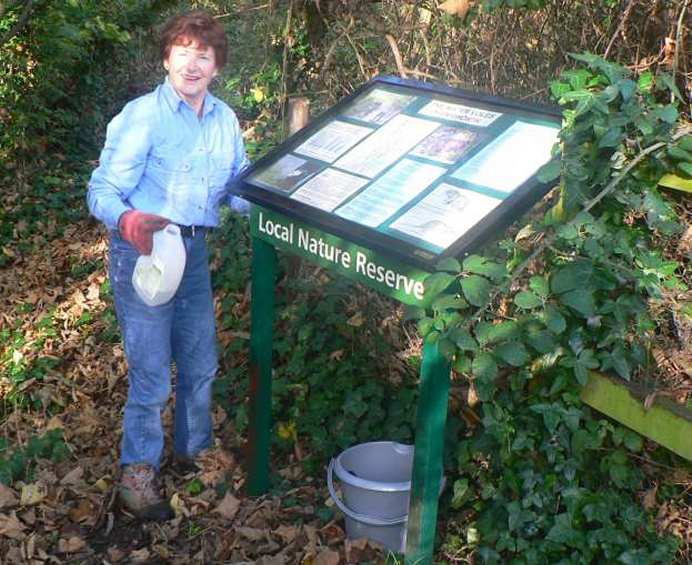
Here
is the Lumley area cleared - a very good job well
done!
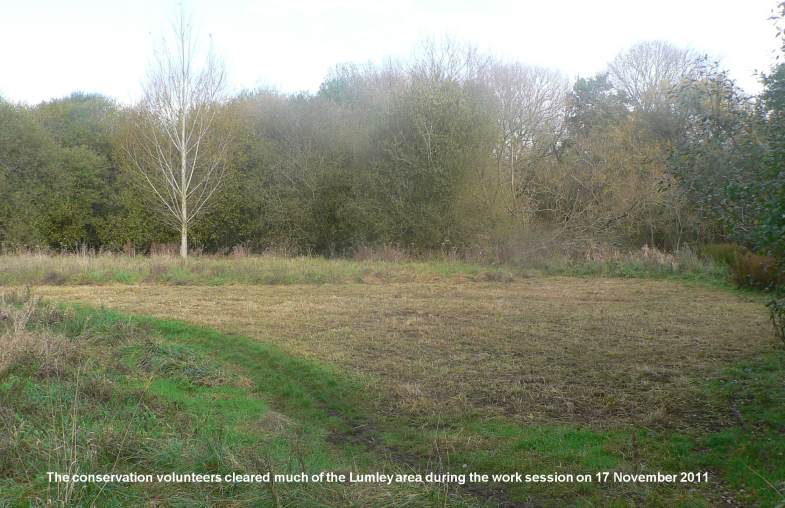
The
first Winter Heliotrope was flowering along the
main river path
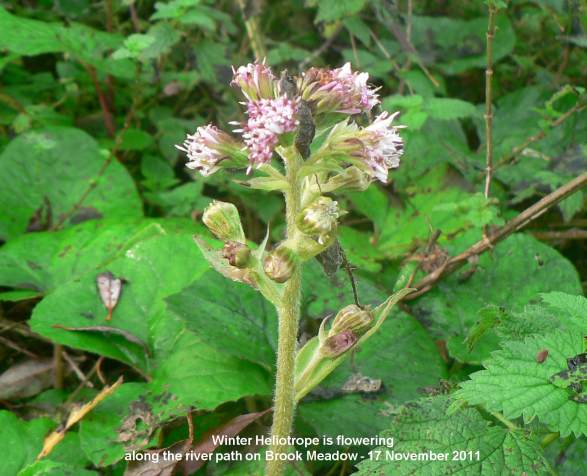
Wednesday
9 November 2011
Annual
cut -
report by Brian Fellows
I spoke to a young
chap named Paul who was clearing the arisings from
an area that has just been cut on the north
meadow.
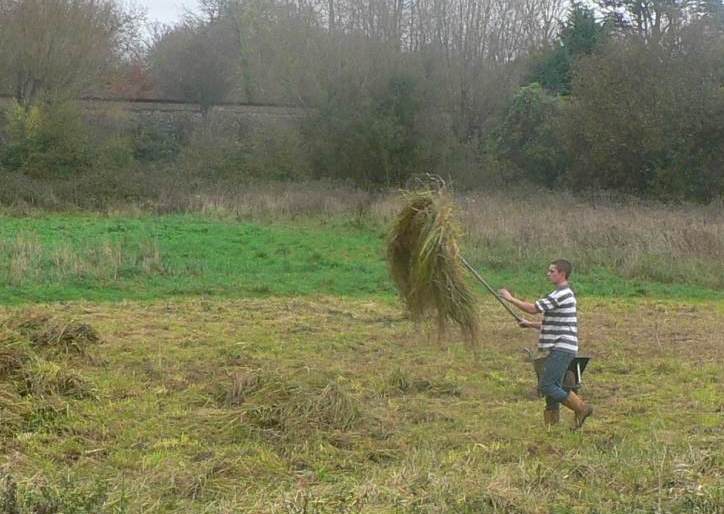
Paul works for John
Blamire who is contracted for the annual cut of the
meadow. This is the final stage of the patchwork
annual cutting that is now standard on Brook Meadow.
It was a long job as Paul not only had to rake the
cuttings but also transport them to the sacrificial
area using a normal wheelbarrow. But from what I could
see he was doing a very good job.
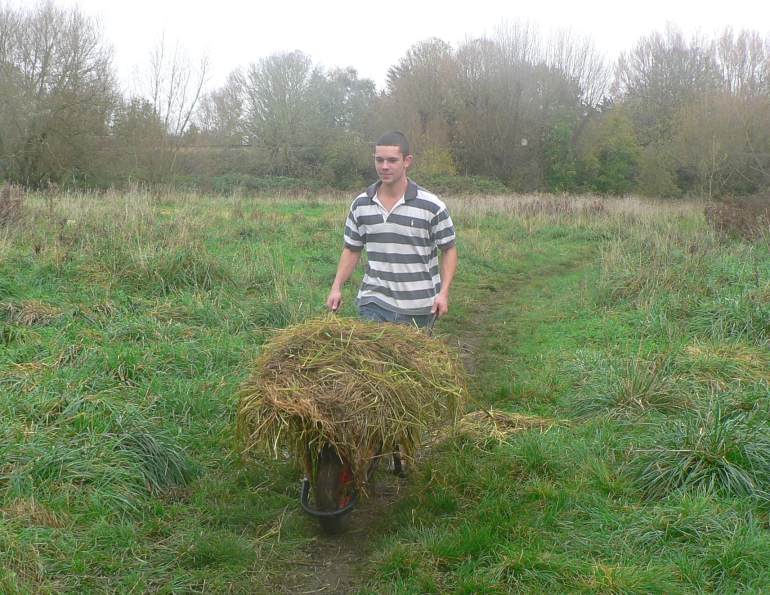
Sunday
6 November 2011
Conservation
work session . . . report
by Wally Osborne. Photos by Brian
Fellows
Contrary to the
forecast, the morning was bright but with a chill wind
which encouraged the 11 Volunteers to get going
promptly on the many tasks listed and awaiting action.
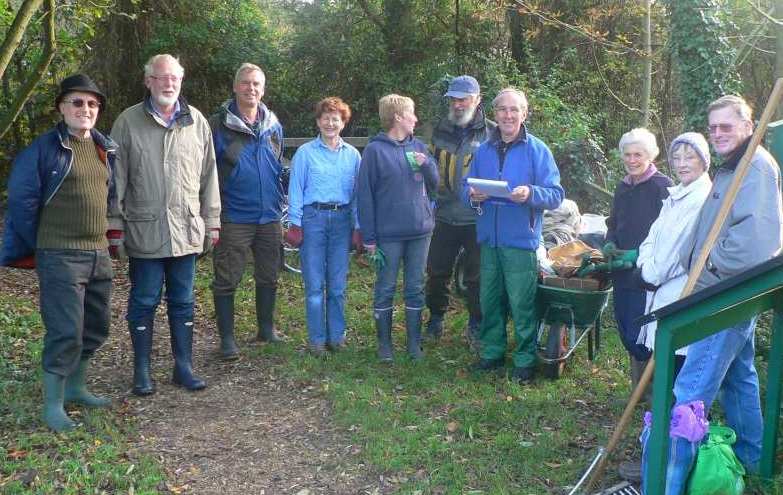
Firstly, Maureen and
Tony Wilkinson set off to cover the badly needed
litter pick of the Palmers Road Copse and everywhere
else, this task taking the best part of an hour.
Tony
keeping Palmer's Road Copse tidy
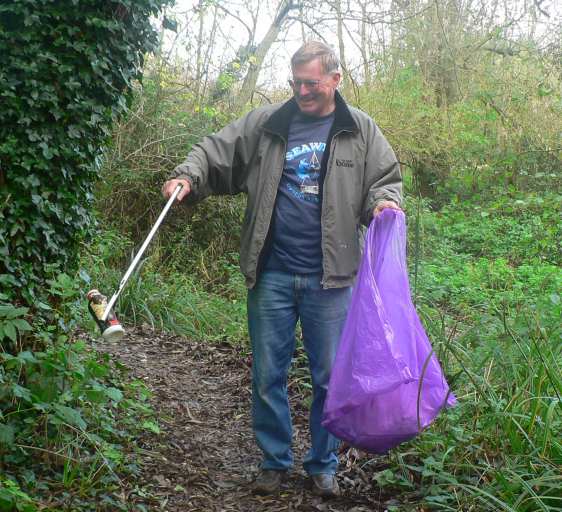
Maureen
litter picking on the edge of the car park

The remainder of us,
Pam, Richard, Lesley, Tony B, Debi, Penny &
Patrick, set about clearing the dense bramble and
nettle growths, crowding out the Alder Buckthorn
plantation on the southern slope of the central bund.
Clearing
the scrub around the Alder Buckthorns
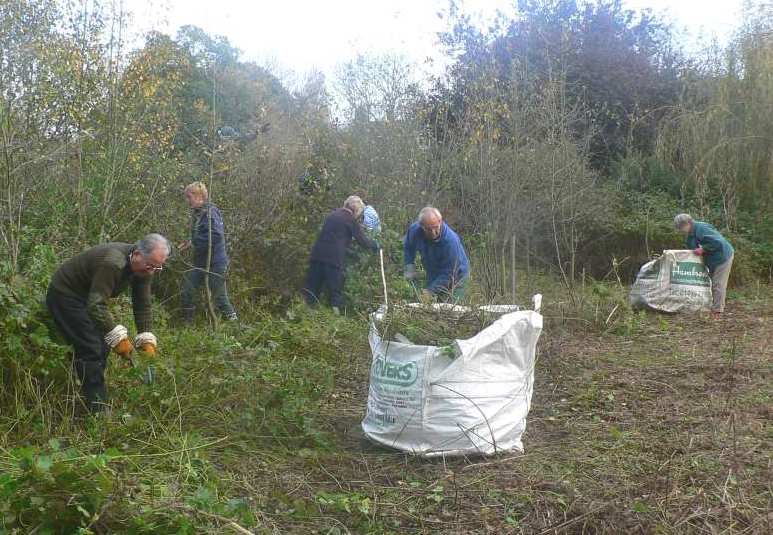
The recent annual cut
of the northern section of the South Meadow has
exposed the site and made this arduous task a little
easier to get at although the cutting with shears,
raking, bagging and removal of the arisings was a
mammoth task. The team stuck at it both before and
after the coffee break served up by Pam.
Careful,
Wally
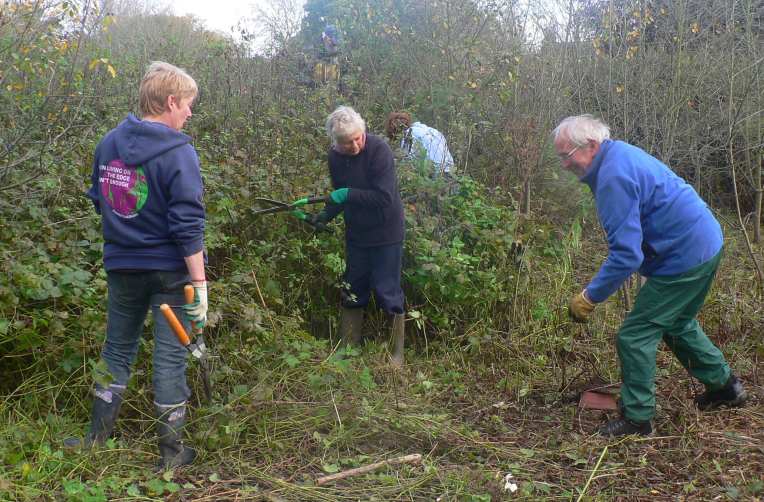
Got
it
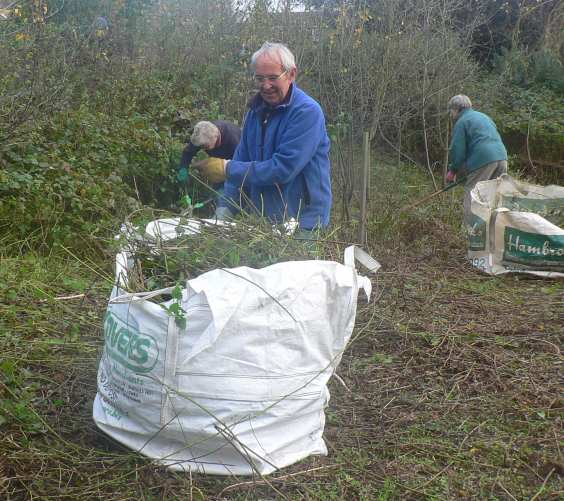
Meanwhile, Maurice
used the Power Scythe to cut a small nearby area of
scrub/low bramble and cut the exposed bramble stems to
ground level where possible. Later, Patrick took over,
to widen the South Meadow occasional paths.
Maurice
handlles the power scythe like an expert
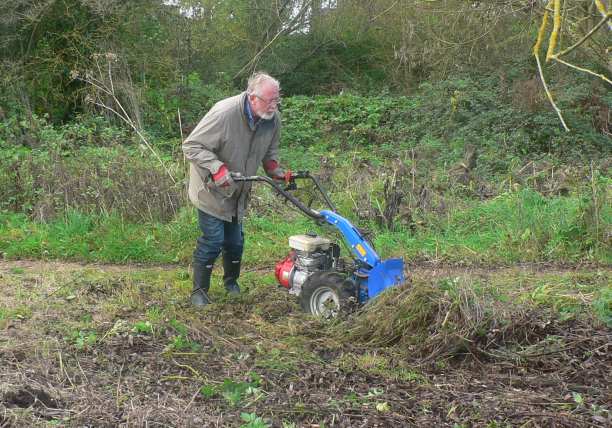
These tasks took the
whole of the session so that the other ones on our
list remain there 'waiting for another day'. We were
pleased to have Brian Fellows on hand to photograph
some of our activities in progress and intend to ask
him to take a picture of the completed job, giving a
'before and after' record.
Here
is the photo of the area cleared by the conservation
group, taken on a very murky November morning.
The clearance was excellent and opens up the Alder
Buckthorns like never before.
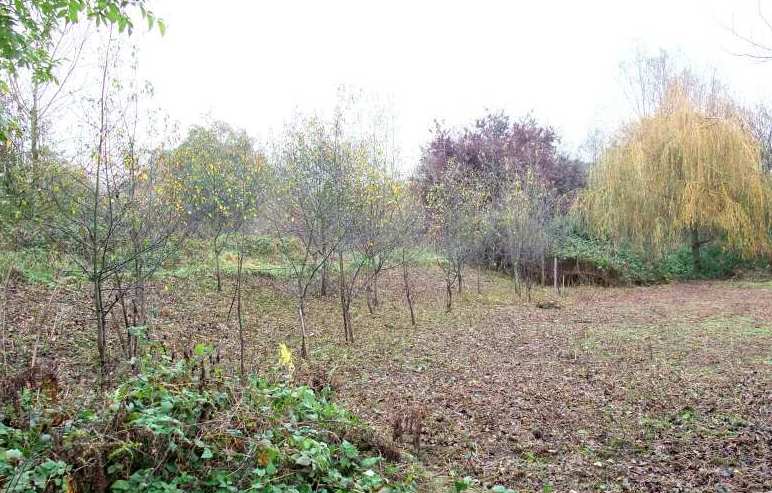
Weasel
As we stood admiring
the results of our labours, Pam spotted a Weasel
coming out of nearby undergrowth and then turning to
dash back in. To our great surprise, all of us then
saw the creature dash 20 metres or so across the open
ground and disappear into a remaining patch of
brambles. Unfortunately, Brian had moved on before
this happening.
This
photo of a Weasel was kindly provided by Mike
Wells
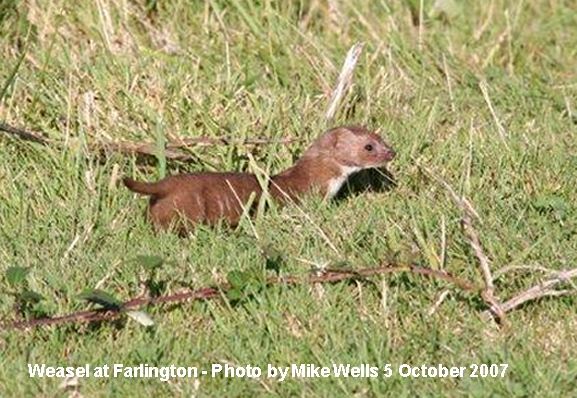
Thanks to all
Volunteers for the sterling efforts which warmed us
through thoroughly and, hopefully, we'll meet again
Thursday 17th November, for an action
replay.
Sunday
2 October 2011
Workday
- Report by
Mike and photos by Brian Fellows
Eleven volunteers met
up on a lovely, hot morning, including a welcome
newcomer, Maureen.
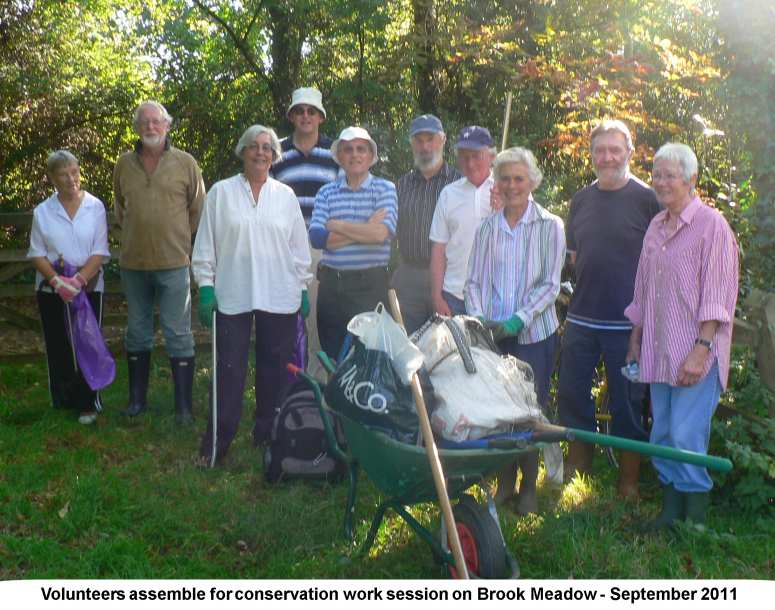
Wally had already made
a head start on cutting the grass paths with the power
scythe and the remainder of the group divided into
teams:
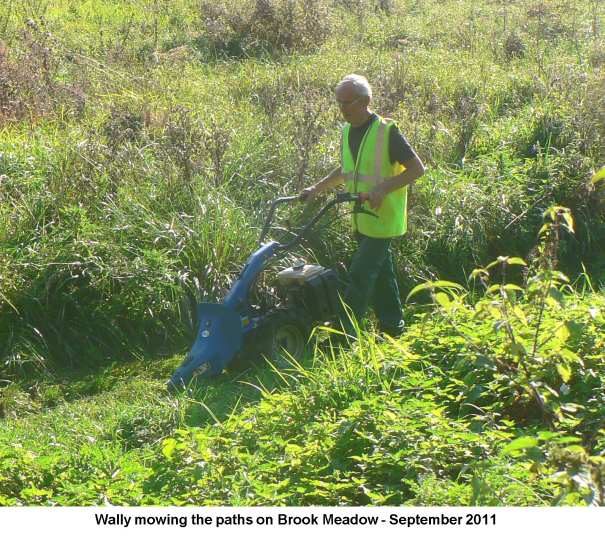
The main team
commenced the trimming of the large willows which had
fallen by the 'S' bend, in preparation for their
removal by tree surgeons at a later date. They cut
back accessible branches and cleared all the brash to
the east bank or the path side. This was a formidable
task. Good progress was made with some more work
needed on the next work day.
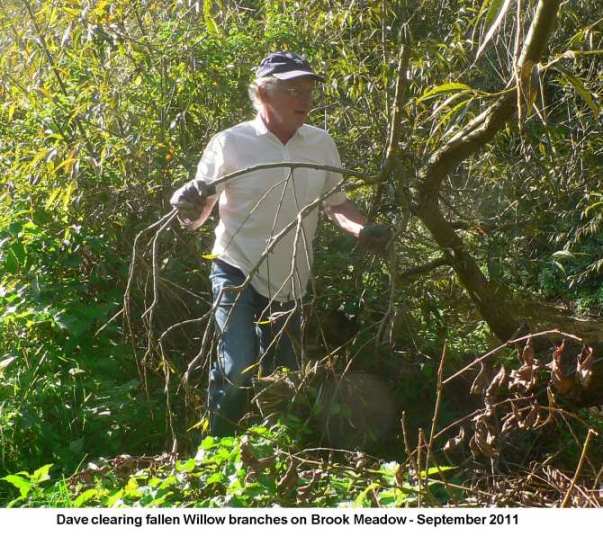
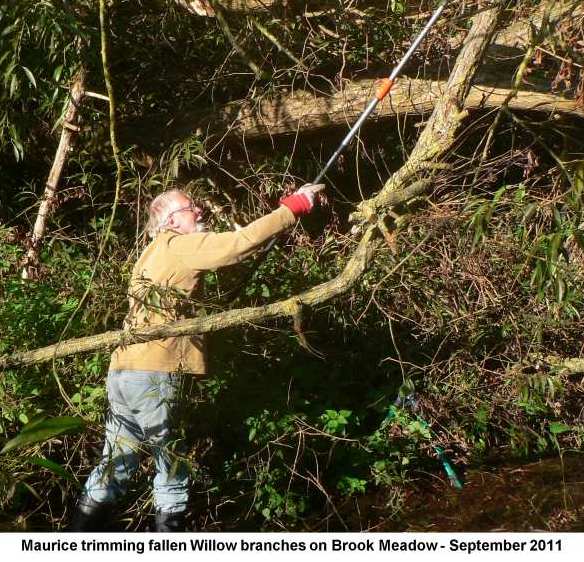
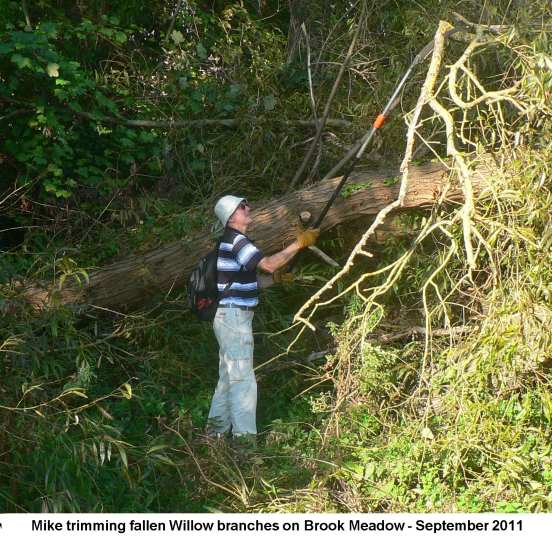
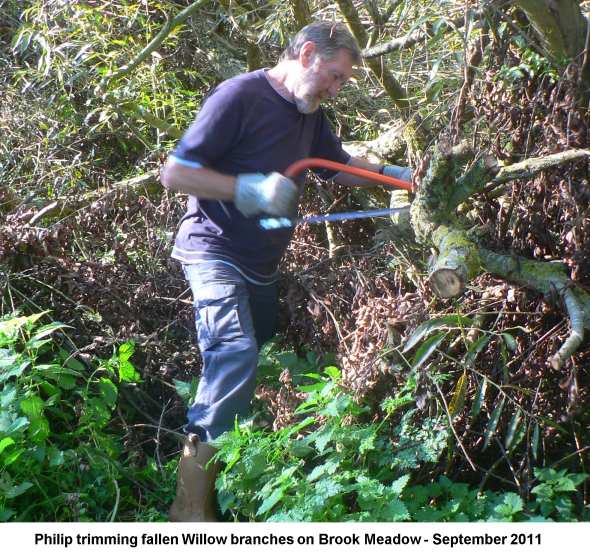
The other teams
trimmed back overhanging vegetation from the hard
paths, litter picked Palmers Road copse and raked up
the path cuttings where necessary. Pam provided
refreshments at half-time, much appreciated in the hot
working conditions.
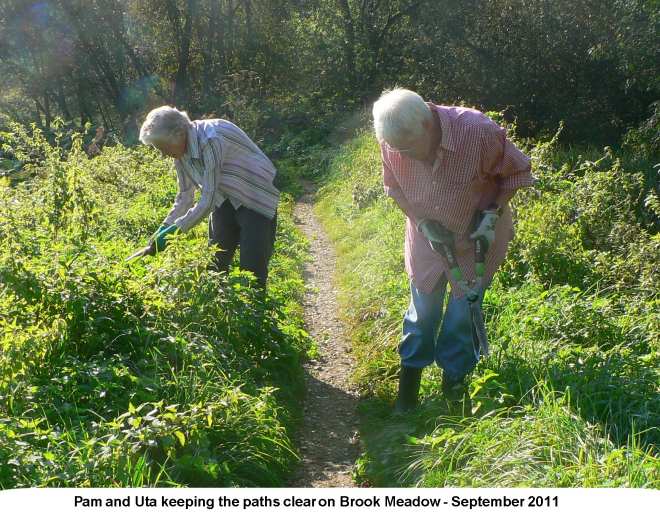
Thursday
15 September 2011
Workday
- report by
Frances Jannaway and photos by Brian
Fellows
It was a gloriously
sunny morning for the select band of 7 volunteers.
Before starting the morning's tasks, Brian pointed out
several important wildflowers which should not be cut
down as they are still flowering and setting seed.
These included Pepper Saxifrage, one of the 8 meadow
indicator plants which is growing well on the eastern
edge of the Lumley wet area. Brian also pointed out
that the litterbin near the north bridge was
overflowing and clearly had not been emptied for quite
some time whereas the other bins had been emptied
regularly. Dealing with this was added to our
tasks.
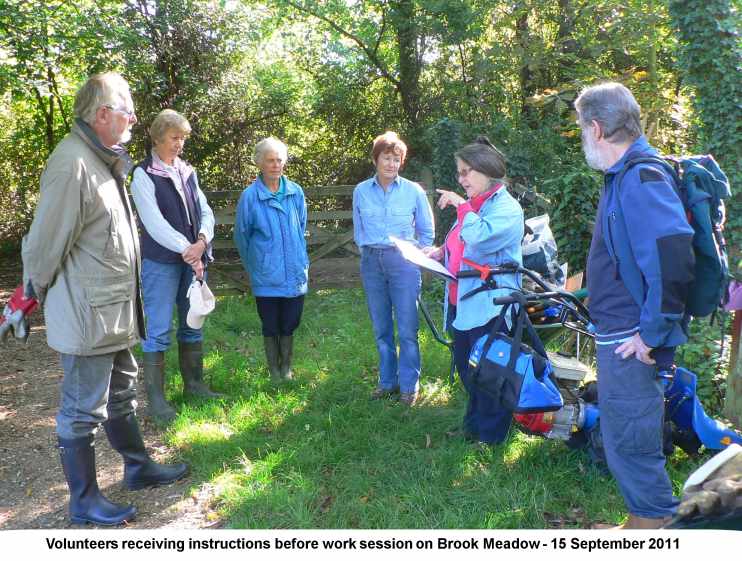
The first task was to
cut with the power scythe (Lesley and Phil) the SE
corner of the South Meadow. This area was not cut last
year. The arisings were raked and removed to a nearby
sacrificial area (Pam, Ute, Frances, & Gaynor).

After cutting and
raking, the vegetation (mainly Sea Couch) became alive
with small frogs and toads jumping every which way
(see below for photos). Several were removed to the
uncut vegetation to avoid damaging them. Meanwhile,
Maurice did a litterpick of Palmers Road copse as well
as cutting back the Hawthorn hedge along the Water
Vole fence to aid visibility from this vantage point.
Although not much litter was found, Maurice did remove
two green containers full of petrol which have been
reported to HBC. Incidentally, if anybody sees or
finds anything on Brook Meadow which shouldn't be
there, please phone HBC Customer Services - 02392
446010.
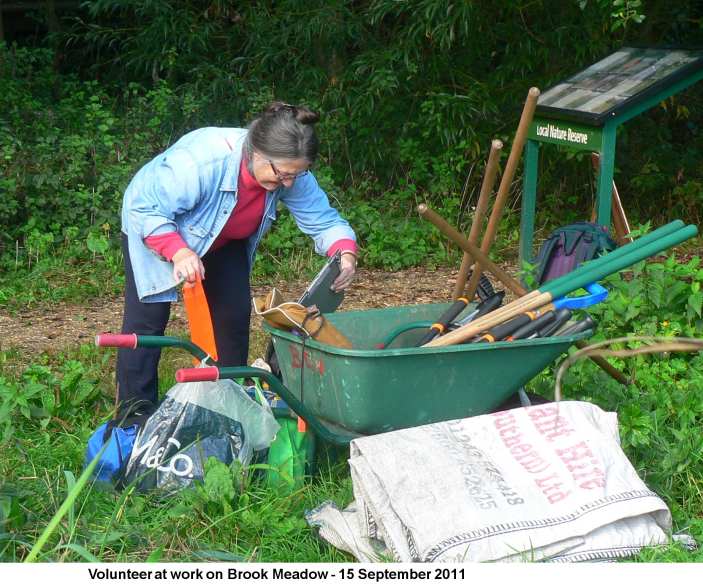
After a well-earned
break provided as usual by Pam, volunteers dug and cut
excess vegetation from both sets of steps near the
central seat, making them safer. The team went on to
clear vegetation from around the young Wild Cherries
and Rowans in the North Meadow and cut down suckers of
Purple-leaved Plum on the southern side of the raised
path near the Lumley gate. And finally, Maurice
emptied the litterbin near the north bridge into
another purple sack but struggled to move it to the
bin near the central seat because it was so heavy,
mainly due to the enormous amount of dog mess
deposited there in bags. The incident was reported to
HBC who removed the very full bag on Friday.
Apparently Dave Lee had already reported the
overflowing bin to HBC last Monday! I am waiting to be
assured by HBC that this omission and health and
safety hazard will not happen again in future. Many
thanks to the small group of volunteers who worked so
hard - a good morning's work!
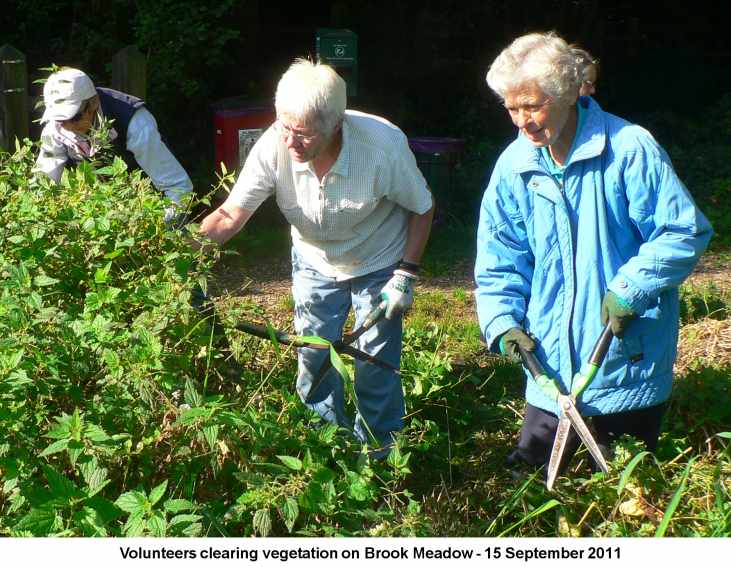
Wildlife
observations
Wildlife seen: a small
brown frog and 2 tiny field mice in a nest, which was
disturbed in the cutting but was returned to the right
spot in the hope that they might survive.
Brian's
comments
From the description
of the nest the mice might have been Harvest Mice. We
have occasionally come across nests on Brook Meadow
during the clearance of vegetation. Here is a photo of
one such Harvest
Mouse nest that
was discovered on Brook Meadow in December 2007.
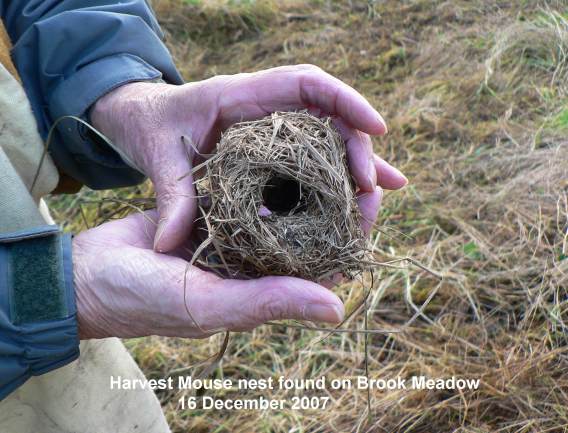
For
earlier Diary entries go to
. . .
2011
- Jan-Jul

